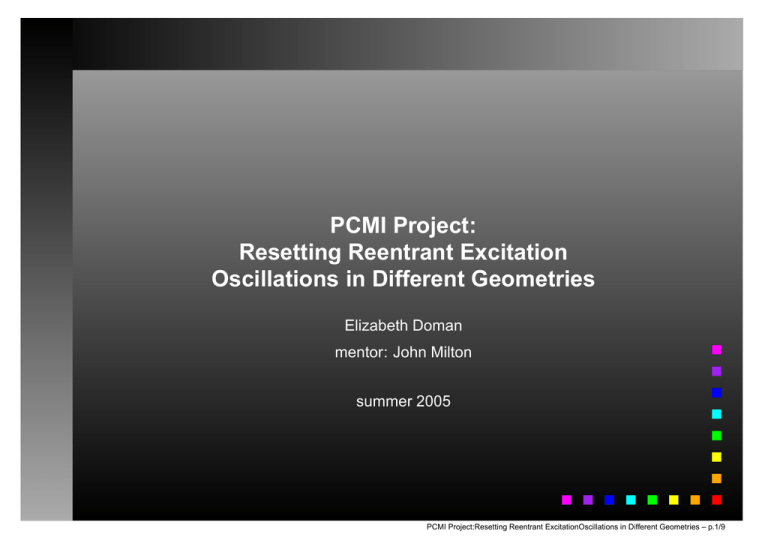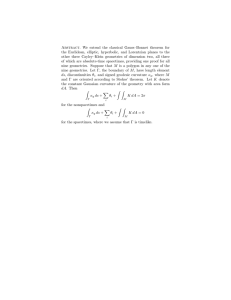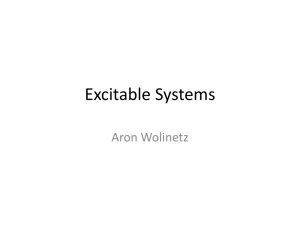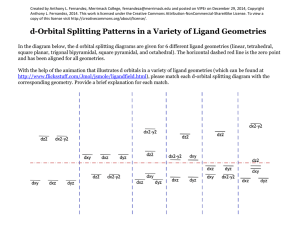PCMI Project: Resetting Reentrant Excitation Oscillations in Different Geometries Elizabeth Doman
advertisement

PCMI Project: Resetting Reentrant Excitation Oscillations in Different Geometries Elizabeth Doman mentor: John Milton summer 2005 PCMI Project:Resetting Reentrant ExcitationOscillations in Different Geometries – p.1/9 motivation... • • • normal rhythm is set by cells in SA node excitation spreads via conduction system cardiac tissue is excitable... ⋆ large enough perturbation from rest =⇒ action potential =⇒ refractory period • Reentrant Tachycardia... ⋆ a conduction pathway loops onto itself → self-sustained oscillation of excitation ⋆ rapid heart rate determined by time it takes excitation to travel around the loop • Goal... ⋆ deliver stimulus to area, utilizing refractory properties, to annihilate tachycardia PCMI Project:Resetting Reentrant ExcitationOscillations in Different Geometries – p.2/9 mechanism for annihilation of tachycardia... • • consequences of refractory property of 1D excitable media... • a stimulus delivered... ⋆ early in the refractory period will produce 0 new waves ⋆ after the refractory period will produce 2 new waves ⋆ in just the right spot will produce only 1 new wave • two waves colliding head on will be annihilated by the refractory periods simple picture of tachycardia.... • • • represent the loop in the conduction system as a 1D ring of excitable media the tachycardia is a traveling wave of excitation on the 1D ring the above observations provide a mechanism for both the annihilation and phase resetting of tachycardia ⋆ can create phase resetting curves to characterize and study the behavior PCMI Project:Resetting Reentrant ExcitationOscillations in Different Geometries – p.3/9 the project... • Goal: to explore this phenomena on different geometries • • ring with a tail • ring with a chord Fitzhugh-Nagumo was the suggested model for excitability • boundary conditions will be challenging for complicated geometries =⇒ so, we took a different approach in modeling excitability... PCMI Project:Resetting Reentrant ExcitationOscillations in Different Geometries – p.4/9 Red-Blue-White model of excitation... ⋆ a number of discrete cells on a ring ⋆ each cell can be in one of four states ⋆ the state of each cell is updated every discrete time step ⋆ each state is assigned an arbitrary numerical value • resting: 0 • excited: +10 • absolutely refractory: −∞ • relatively refractory: −c .. −1 ⋆ input variables... b = length of absolute refractory period c = length of relative refractory period N = how many cells on a ring ⋆ show movie of pulse on a ring with N = 50, b = 5, c = 5 PCMI Project:Resetting Reentrant ExcitationOscillations in Different Geometries – p.5/9 adding a stimulus... • • • s = strength of the stimulus (note: s ≥ 1) ts = time, or phase, at which the stimulus is applied to the ring if the stimulus is delivered to... (i) absolutely refractory cell → no response (ii) resting cell → 2 new waves propagate in opposite directions (iii) relatively refractory cell... ⋆ early in the relative refractory period → no response ⋆ late in the relative refractory period → 1 new wave propagates back ⋆ show movies for various t s with N = 50, b = 5, c = 5, s = 4, and threshold=+1 PCMI Project:Resetting Reentrant ExcitationOscillations in Different Geometries – p.6/9 phase resetting curve... • • T0 = time it takes the original pulse to travel around the ring once φs = phase of the stimulus (with respect to a reference cell) • • • • • φs = 1/N ⇒ stim is applied to ref cell when the orig pulse is also at that point φs = 1/2 ⇒ stimulus is applied when original pulse is halfway around the ring φs = 3/4 ⇒ stimulus is applied when original pulse is a 3 4 the way around φs = (N + 1)/N ⇒ same result as φs = 1/N if a stimulus is applied at a given phase... • • T1 is the time since the ref point last saw a pulse to when it sees another in general.. • Tj is the time at which the ref point has seen another j pulses PCMI Project:Resetting Reentrant ExcitationOscillations in Different Geometries – p.7/9 phase resetting curve... phase resetting curve for N=20, b=2, c=2 2 for a given N , b, c, and s, stimulate the reference cell at various phases, and calculate T1 • we get the same type of curves generated by Fitzhugh-Nagumo excitability (Glass,1995) 1 T /T 0 • 1 0 0 0.1 0.2 0.3 0.4 φ 0.5 0.6 0.7 0.8 0.9 1 stim PCMI Project:Resetting Reentrant ExcitationOscillations in Different Geometries – p.8/9 so what... • why did we take this approach... ⋆ wanted to develop a simple way to observe the behavior found in FN • • annihilation and phase resetting reproduce the phase resetting curves ⋆ modify this simple code for different for geometries ⋆ perhaps examine periodic stimulation ⋆ then, moving into a continuous PDE model, we might know what to look for • of course, there might be more interesting behavior in the PDE model, but... ⋆ this simple discrete model is a good way to investigate the complicated problem and gets us (me) thinking about the behavior of excitable media in general, and the corresponding rules that govern its behavior PCMI Project:Resetting Reentrant ExcitationOscillations in Different Geometries – p.9/9



